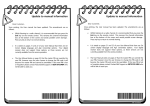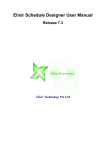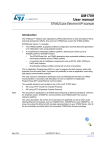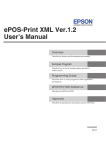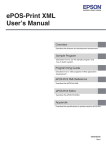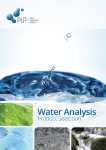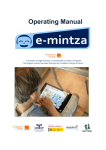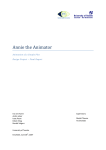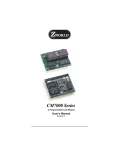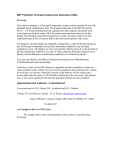Download here. - Benjamin Lin
Transcript
ICFlash: Web-based Network Measurement Using Adobe AIR
CSE 534 Final Research Paper
Jian Xu1, Benjamin X. Lin1, Yang Sheng Fang1
1
Department of Computer Science, Stony Brook University,
Stony Brook, NY 11794-4400
{jianxu1, xianlin, yafang}@cs.stonybrook.edu
http://www.ic.sunysb.edu/stu/xianlin/~cse534
ABSTRACT
In order to help ICLab [1] collect data for censorship
related researches, we develop ICFlash, a network
measurement application embedded on a webpage. In
specific, ICFlash allows an end user to issue HTTP GET
requests or DNS queries to a remote web server and upload
corresponding results to the Centinel Server. We implement
ICFlash by using Adobe AIR, after investigating the
feasibility of HTML5, JavaScript, PHP, Adobe Flash and
AIR, since AIR does not have the cross-domain restriction.
We describe our design and implementation details,
provide the user manual and sample results of ICFlash
application, and outline the future work.
Key Words: Cross-Domain, Adobe Flash, Adobe AIR,
HTTP, DNS, Centinel Server
1. INTRODUCTION
Currently, the ICLab [1] application requires an end user
to download the Centinel Client and run it locally to collect
enough information for research purposes. It requires too
complex configurations and installation steps that may limit
the number of users who are willing to participate in this
censorship data collection program.
We create an Adobe AIR application named ICFlash for
web browsers, enabling users to help ICLab collect HTTP
and DNS data by simply typing URL links and clicking
buttons. In order to implement these functions, ICFlash first
issues an HTTP GET request (or DNS query) to the web
server designated by the URL; then it uploads the HTTP (or
DNS) response to the Centinel Server.
In the rest of this paper, we firstly review the background
(Section 2) technologies that may be used for ICFlash and
briefly describe why we reach our decision of using Adobe
AIR. Next, we introduce the design of our application
(Section 3), followed by its implementation (Section 4). We
present the prototype of ICFlash in Section 5, discuss the
future work in Section 6, and conclude in Section 7.
2. BACKGROUND
In this section, we review several web technologies for
their feasibility in ICFlash.
2.1 HTML5
HTML5 is a core technology markup language of the
Internet used for structuring and presenting content for the
World Wide Web. It is derived from HTML4, which was
standardized in 1997. Comparing to HTML4, a great
improvement of HTML5 is the support of the latest
multimedia technology [2].
Some new features were designed to make it easy to
include and handle multimedia and graphical content on the
web without having to resort to proprietary plugins and
APIs. Additionally, several technologies were applied in
HTML5 to support specific features, like WebSocket API, to
provide full-duplex communication channels over a single
TCP connection [3]. So we can apply Websocket API to issue
HTTP requests to servers.
While in this case in order to process successfully,
servers that accept the WebSocket protocol requests have to
support the protocol by upgrading. This is hardly practical in
our project since we have to urge all the web servers to
upgrade to support the Websocket protocol.
Therefore, applying HTML5 with Websocket API is not
practical in our project.
2.2 JavaScript
JavaScript is a language supported by all modern web
browsers. It complements HTML and CSS by providing
client-side scripting. JavaScript is commonly used to change
the document content, control the browser window,
communicate asynchronously with the web server, and do
complex math calculations [4]. Consequently, many web
applications and games use JavaScript.
While JavaScript provides some APIs to communicate
with servers, it is restricted by the cross-domain policy. This
policy does not permit sending requests to another website
with a different domain name. Because our application needs
to send requests to other domains, this technology is not
suitable.
1
2.3 PHP
PHP is a server-side scripting language designed for
web development, in which case PHP generally runs on a
web server (e.g. Apache, Nginx, etc.)
PHP code can be mixed with HTML code to construct a
dynamic webpage. It is usually processed by a PHP
interpreter, which is often implemented on the web server
side by a server native module or a Common Gateway
Interface (CGI) executable. After the PHP code is
interpreted and executed, the web server sends the resulting
output to its client, usually in form of a part of the generated
web page; for example, PHP code can generate a web page's
HTML code, an image, or some other data [5].
www.a.com. This policy demonstrates a huge restriction on
what we want to achieve, which is to send requests to any
domain. And, it is impractical for us to ask web
administrators to grant our application access to their web
servers. Therefore, we opt not to use Flash.
2.5 Adobe AIR
Adobe AIR supports the full Adobe Flash API so that
it gains all the advantages of Flash. In addition, AIR provides
an API named flash.net.dns for DNS queries and other APIs
supporting file system integration and access to connected
devices. The AIR runtime supports installable applications
on Windows, OS X and mobile operating systems like
Android, iOS and BlackBerry Tablet OS [10].
According to the fact that PHP is a server-side scripting
language and can only be executed on the server side, this
makes us have to execute our program remotely. Therefore,
servers instead of browsers will send the DNS/HTTP
requests that we embed in PHP programs. Results will reflect
the accessibility in servers’ perspective instead of users
which is not what we intend to measure.
Another advantage of Adobe AIR is allowing Adobe
Flash and ActionScript code to construct applications that
run outside of a web browser, and behaves like a native
application on supported platforms [10].
Alternatively we can achieve our goal by deploying
LAMP-like environment in client-side (e.g. LAMP [6],
MAMP [7], WAMP [8]) where to let PHP scripts execute on,
but this approach breaches our principle that do not install
heavy packages and complex configurations on the client
side.
According to the investigations on HTML5, JavaScript,
PHP, Flash and AIR technologies, we find that AIR is a
suitable platform for our application because AIR does not
have the cross-domain restriction and also provides APIs
accessing low level streams. Therefore, we decide to
implement ICFlash using AIR.
As a consequence, PHP is not an ideal method for this
project.
The most important point is that AIR does not have the
cross-domain restriction. Consequently it allows us to send
HTTP requests to arbitrary servers [10].
3. DESIGN
2.4 Adobe Flash
Adobe Flash is a common user-side presentation
platform in modern web applications. Its common usage
includes video player, animation, website navigation, and
complex application (such as image editor). It supports
cross-platforms running on Windows, Mac OS, and Linux.
It not only has a wide number of platform supports, but also
gains a huge user base.
Flash application is written in ActionScript with various
front-end technologies. The source code is compiled into a
Shockwave Flash file (i.e. SWF file).
SWF files can be embedded in web pages, and they must
be running on a system with Adobe Flash installed.
Flash provides certain APIs that do not exist in
browsers. These APIs include TCP streams and custom TCP
requests, which are crucial to our application
implementation.
However, Flash enforces certain security policies. One
of such is the cross-domain policy [9]. The target server
which the Flash application tries to access, must grant
permission to the domain where the Flash application
resides, by including a “crossdomain.xml” file on its own
server. For example, if a Flash application on www.a.com
wants to access www.b.com, www.b.com must include
“crossdomain.xml” on its root that grants permission to
Figure 1. Interaction between ICFlash and other systems
Figure 1 presents an overview of ICFlash’s workflow.
Initially, the user visits our web server to download
ICFlash application. Next, the user can use a specified URL
or our predefined URL list to send HTTP GET requests or
DNS queries to the target server. After that, ICFlash records
2
the response from the server and presents the result to the
user. If the request is an HTTP GET, the result will include
HTTP response status code, response URL, the name-value
pairs of the HTTP header and HTML content. If the request
is a DNS query, the result will contain one or more IP
addresses for the requested domain name. In both cases
ICFlash will record the round-trip time (RTT). Finally, with
the user’s consent, ICFlash sends the response data to the
ICLab Centinel Servers for further analysis.
request detailed as mentioned previously except the method
property being changed to POST instead of GET. We embed
the JSON string into the data property separated by
boundaries as complied with the HTTP standard [16].
4. IMPLEMENTATION
Then we upload the whole folder containing “Badge”
files to our server, allowing users to test our application.
4.1 User Interface
Our user interface is written in Flex. Flex is an SDK for
developing user interface for the Adobe Flash platform. One
advantage of Flex is to provide consistent user experience on
all major browsers, desktops, and devices [14]. Flex is based
on XML technology so the code is easy to write and
maintain.
4.4 Embedding Air into a Web Page
We compile our code into an AIR installer and then
deploy it to our current server. We use a collection of sample
html files named “Badge” from the official Adobe site [12].
Then we replace the AIR file with ours, and modify the AIR
version and the absolute URL to our AIR file.
5. PROTOTYPE
5.1 User Interface
The user interface of ICFlash looks like Figure 2.
An example of Flex component we used is the Datagrid,
which provides a multiple column table for displaying our
result. We add a row in the datagrid for each result we
received. In each row, we show the original domain URL,
the status code, the round-trip time, and the uploading status.
We also add an event listener to the datagrid to handle users’
interactions. When the user clicks on a record in the datagrid,
the textbox on the right of the Result Panel will be updated
to show details of that result record.
4.2 Library
In order to implement the function of sending HTTP
GET requests, we use the flash.net API [11] from the Flash
library. We first build a URLRequest object, which stores
various parameters related to the HTTP request. We set the
method property to GET, and the contentType to "text/html".
Then by using an instance of URLLoader, our application
sends an HTTP request to a remote server. An event handler
is used to asynchronously process the response. We extract
the data and then present it.
We use the flash.net.dns API to send DNS queries. With
a DNSResolver object, we use the lookup method to resolve
a domain name to obtain its IPv4 address. In the event
handler, we process the result in the DNSResolverEvent
object and display the data in our user interface.
Figure 2. The user interface of ICFlash
5.2 User Manual
Step 1: The user needs to visit the webpage with ICFlash
embedded, as shown in Figure 3.
4.3 Result Uploading
In order to let ICLab easily decode the result, we choose
the JSON encoding. JSON is an open standard format that
uses human-readable text to transmit data objects consisting
of attribute–value pairs [15]. Some examples we used include:
the attribute body paired with the result HTML body, the
attribute time paired with the round-trip time, and so on.
We then upload this JSON encoded result onto the
Centinel Server. Because the Centinel Server uses REST [17]
architecture, we can upload the result by sending an HTTP
POST request. We use the method similar to HTTP GET
Figure 3. The initial webpage to start ICFlash installation
3
Step 2: The user clicks the “Install Now” button.
ICFlash asks the user whether or not he wants to open and
run it as shown in Figure 4.
Step 5: By clicking the “Continue” button, the
installation of ICFlash will start.
After the installation is finished, the interface of ICFlash
will pop up, as shown in Figure 2.
Then the user can click the “Manual” tab on the
interface to start his testing.
5.3 Result
5.3.1
Figure 4. Installation Prompt
Step 3: The user will see the warning message in Figure
5. By clicking “Install” button, he confirms his decision of
installing.
Result of an HTTP GET Functionality
After the user inputs a correct website URL, selects
HTTP in the dropdown menu, and then clicks “Test” button,
he will see the HTTP status code, the round-trip time (RTT)
and the status for this result to be uploaded in the grid on the
left of the Result Panel; after clicking the record in the grid,
he will further see the HTML content of the website on the
right of the panel, as shown in Figure 7.
Figure 7. Result of an HTTP GET functionality
Figure 5. Request uer confirmation
Step 4: Then ICFlash asks the location where he wants
to install it as shown in Figure 6.
5.3.2
Result of an DNS Query Functionality
Similarly, if the user inputs a site URL, selects DNS in
the dropdown menu, and then clicks “Test” button, he will
see the RTT to run this DNS query and its uploading status;
after he further clicks the record, ICFlash will display the
detailed DNS query results on the right of the Result Panel,
as shown in Figure 8.
Figure 6. Installation Path
4
Figure 9.2. The corresponding DNS
query result on the server side
Figure 8. Result of an DNS query functionality
By clicking the “Clear” button below the grids, the user
can always remove the current results displayed on the panel.
5.3.3
Send Collected Results to a Local
Centinel Server
We have enabled the functionality for the user to upload
the previously obtained result to a locally deployed Centinel
Server in JSON format. The user simply needs to click the
result record shown in the grid, modifies the IP Address
Field to the right of the “Clear” button, and then click
“Upload” button. After clicking the “YES” button to
prompted security alerts, he will see the uploading status of
this result changes from “ready” to “uploading” then to
“done”, as shown in Figure 9.1. Simultaneously, the local
Centinel Server logs the result sent by the user, as shown in
Figure 9.2. If error occurs in the uploading process, the
status code for the result would display “error”, as shown in
Figure 9.3.
Figure 9.3. A result when uploading failed
5.3.4
Allow Users to Automatically Test a
List of URLs
Besides the required functionalities we have
implemented, as illustrated in Section 5.3.1 to 5.3.3, we have
also implemented a feature to supply a list of URLs for a user
to test in sequence, as shown in Figure 10. Similarly, when
the user clicks any result record in the grid, he will see the
detailed result on the right of the Result Panel. The
functionality of uploading results to the local Centinel Server
is also available.
Figure 9.1. A successful result uploading from the user side
Figure 10. Result from executing a list of HTTP GET requests
5
6. FUTURE WORK
[2] http://en.wikipedia.org/wiki/HTML5
Till now, we have overcome the cross-domain
restriction, completed the HTTP GET and DNS query
modules, the uploading to a locally deployed Centinel Server
functionality [13] and an extra feature of including a list of
URLs for a user to test in batch.
[3] http://en.wikipedia.org/wiki/WebSocket
For the future, we plan to give users more flexibility by
allowing them to upload a customized list of URLs to test.
Moreover, we will contact the administrator of ICLab
Centinel Server Project to figure out the way of uploading
users’ testing results to the actual Centinel Server instead of
a locally deployed one. Last but not the least, we would
coordinate with ICLab to promote our ICFlash application to
the volunteers who participated or are willing to participate
in ICLab’s data collection program over the world.
[7] http://en.wikipedia.org/wiki/MAMP
7. CONCLUSION
[4] http://en.wikipedia.org/wiki/JavaScript
[5] http://en.wikipedia.org/wiki/PHP
[6] http://en.wikipedia.org/wiki/LAMP_(software_bundle)
[8] http://en.wikipedia.org/wiki/LAMP_(software_bundle)#WA
MP
[9] http://help.adobe.com/en_US/ActionScript/3.0_Programming
AS3/WS5b3ccc516d4fbf351e63e3d118a9b90204-7e3f.html
[10] https://en.wikipedia.org/wiki/Adobe_AIR
[11] http://help.adobe.com/en_US/FlashPlatform/reference/action
script/3/flash/net/package-detail.html
[12] Adobe Getting started with the custom install badge.
https://www.adobe.com/devnet/air/articles/badge_for_air.ht
ml
In order to get HTTP/DNS information from users’
perspective via browsers, we implement a web-based
application named ICFLash. In this paper we first investigate
the feasibility of several technologies such as HTML5,
JavaScript, PHP and Adobe Flash.
[13] Discussion of our project scope with Abbas Razzaghpanah, a
PhD student participating in the Internet Censorship Lab.
Friday, April 03, 2015
Then we eliminate those technologies, as they are not
able to satisfy our requirements. For instance, we cannot get
user-perspective information from servers executing PHP;
since not all servers support WebSocket protocol, it is
impossible to deploy a general application which sends
WebSocket requests via HTML5; because JavaScript and
Flash are subjected to the cross-domain policy, they are
impractical for us to apply, either.
[16] Form-based File Upload in HTML.
https://tools.ietf.org/html/rfc1867
[14] Flex. https://www.adobe.com/products/flex.html
[15] https://en.wikipedia.org/wiki/JSON
[17] https://en.wikipedia.org/wiki/Representational_state_transfer
Hence, we decide to use Adobe AIR technology due to
its capability of satisfying our project requirements and
convenient deployment, for instance, to acquire userperspective accessibility to web servers.
Next, we describe several key steps on how to realize
the project, for example, how to send HTTP GET requests
and DNS queries by using Adobe AIR APIs, how to upload
the corresponding results to the Centinel Server in JSON
format, etc.
We also demonstrate the user manual of how to install
and use the ICFlash step by step.
Finally, we look into the future work of ICFlash,
planning to give users more flexibility of customizing a list
of URLs to test, coordinate with the ICLab administrator for
uploading testing results to the actual Centinel Server, and
promoting our ICFlash application to the volunteers who
participate in ICLab’s data collection program over the
world.
8. REFERENCES
[1] The Internet Censorship Lab:
http://www.internetcensorshiplab.com/
6






